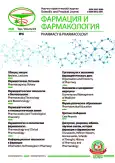Number of runs variations on Autodock 4 do not have a significant effect on RMSD from docking results
- Authors: Pratama M.F.1,2, Siswandono S.1
-
Affiliations:
- Airlangga University
- Muhammadiyah Palangkaraya University
- Issue: Vol 8, No 6 (2020)
- Pages: 476-480
- Section: Articles
- URL: https://journals.rcsi.science/2307-9266/article/view/111677
- DOI: https://doi.org/10.19163/2307-9266-2020-8-6-476-480
- ID: 111677
Cite item
Abstract
The aim. The number of runs in the docking process with AutoDock 4 is known to play an important role in the validity of the results obtained. The greater the number of runs it is often associated with the more valid docking results. However, it is not known exactly how the most ideal runs in the docking process with AutoDock 4. This study aims to determine the effect of the number of runs docking processes with AutoDock 4 on the validity of the docking results.
Materials and methods. The method used is the redocking process with AutoDock 4.2.6. The receptor used is an estrogen receptor with ligand reference estradiol (PDB ID 1GWR). Variations were made on the number of runs from 10 to 100 in multiples of 10. The parameters observed were RMSD, free energy of binding, inhibition constants, amino acid residues, and the number of hydrogen bonds.
Results. All experiments produce identical bond free energy, where the maximum difference in inhibition constant is only 0.06 nM. The lowest RMSD is indicated by the number of runs of 60, with a RMSD value of 0.942. There is no linear relationship between the number of runs and RMSD, with R in the linear equation of 0.4607.
Conclusion. Overall, the number of runs does not show a significant contribution to the validity of the results of docking with AutoDock 4. However, these results have only been proven with the receptors used.
Keywords
Full Text
##article.viewOnOriginalSite##About the authors
Mohammad Rizki Fadhil Pratama
Airlangga University; Muhammadiyah Palangkaraya University
Email: m.rizkifadhil@umpalangkaraya.ac.id
ORCID iD: 0000-0002-0727-4392
Ph.D. student of Pharmaceutical Chemistry from Doctoral Program of Pharmaceutical Sciences; Assistant Professor of Medicinal Chemistry from Department of Pharmacy
Indonesia, Dr. Ir. Soekarno St. Сampus C, Mulyorejo, Surabaya, East Java, Indonesia 60115; RTA Milono St. Km. 1.5, Pahandut, Palangka Raya, Central Kalimantan, Indonesia 73111S. Siswandono
Airlangga University
Author for correspondence.
Email: prof.sis@ff.unair.ac.id
ORCID iD: 0000-0002-9579-8929
Professor of Medicinal Chemistry from Department of Pharmaceutical Chemistry
Indonesia, Dr. Ir. Soekarno St. Сampus C, Mulyorejo, Surabaya, East Java, Indonesia 60115References
- Ferreira LG, Dos Santos RN, Oliva G, Andricopulo AD. Molecular docking and structure-based drug design strategies. Molecules. 2015;20(7):13384–421. doi: 10.3390/molecules200713384.
- Sliwoski G, Kothiwale S, Meiler J, Lowe EW. Computational Methods in Drug Discovery. Pharmacological Reviews. 2014;66(1):334–95. doi: 10.1124/pr.112.007336.
- Pagadala NS, Syed K, Tuszynski J. Software for molecular docking: a review. Biophysical Reviews. 2017;9(2):91–102. doi: 10.1007/s12551-016-0247-1.
- Kontoyianni M, McClellan LM, Sokol GS. Evaluation of docking performance: comparative data on docking algorithms. Journal of Medicinal Chemistry. 2004;47(3):558–65. doi: 10.1021/jm0302997
- Kufareva I, Abagyan R. Methods of protein structure comparison. Methods in Molecular Biology. 2012;857:231–57. doi: 10.1007/978-1-61779-588-6_10
- Guedes IA, de Magalhaes CS, Dardenne LE. Receptor–ligand molecular docking. Biophysical Reviews. 2014;6(1):75–87. doi: 10.1007/s12551-013-0130-2
- Lape M, Elam C, Paula S. Comparison of current docking tools for the simulation of inhibitor binding by the transmembrane domain of the sarco/endoplasmic reticulum calcium ATPase. Biophysical Chemistry. 2010;150(1–3):88–97. doi: 10.1016/j.bpc.2010.01.011
- Ramirez D, Caballero J. Is It Reliable to Take the Molecular Docking Top Scoring Position as the Best Solution without Considering Available Structural Data? Molecules. 2018;23(5):1038. doi: 10.3390/molecules23051038
- Forli S, Huey R, Pique ME, Sanner M, Goodsell DS, Olson AJ. Computational protein-ligand docking and virtual drug screening with the AutoDock suite. Nature Protocols. 2016;11(5):905–19. doi: 10.3390/molecules23051038
- Arba M, Yamin, Ihsan S, Tjahjono DH. Computational approach toward targeting the interaction of porphyrin derivatives with Bcl-2. Journal of Applied Pharmaceutical Science. 2018;8(12):60–6. doi: 10.7324/JAPS.2018.81208
- Atkovska K, Samsonov SA, Pszkowski-Rogacz M, Pisabarro MT. Multipose Binding in Molecular Docking. International Journal of Molecular Sciences. 2014;15(2):2622–45. DOI: https://doi.org/10.3390/ijms15022622
- Feinstein WP, Brylinski M. Calculating an optimal box size for ligand docking and virtual screening against experimental and predicted binding pockets. Journal of Cheminformatics. 2015;7:18. DOI: https://dx.doi.org/10.1186/s13321-015-0067-5
Supplementary files








